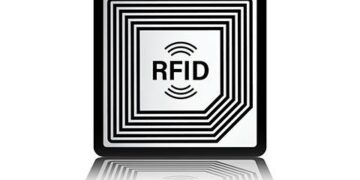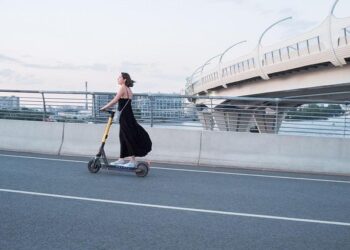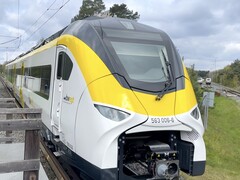 The Mireo Plus B on the T1 test track in Wegberg-Wildenrath (Photo: Andreas Sebayang/Notebookcheck.com)
The Mireo Plus B on the T1 test track in Wegberg-Wildenrath (Photo: Andreas Sebayang/Notebookcheck.com)
Background: In Wegberg-Wildenrath, Notebookcheck.com was able to take a look at (and take lots of pictures of) the latest electric multiple units (EMUs) with LTO (lithium titanate oxide) batteries and fuel cells, which can run independently of an overhead line (electrical cable). We also show the first large fleet scenario that will take place around Berlin.
Andreas Sebayang, ✓ Brian Burriston (translated by DeepL / Ninh Duy), Published 06/23/2023 🇩🇪
In Germany, many lines are still not electrified. Where traffic is less, Siemens electric multiple units will be in operation in the near future. They are based on the Mireo platform, a lightweight commuter train that normally runs under overhead line, or catenary. Not so the two Mireo Plus H and Mireo Plus B variants, which Siemens presented in detail to the press last week. The latter (Plus B for battery) even made its driving debut. The H train, which is powered by hydrogen, was also allowed to demonstrate its acceleration performance for the first time in the inner test ring T2, while the Plus B ran on ring T1.
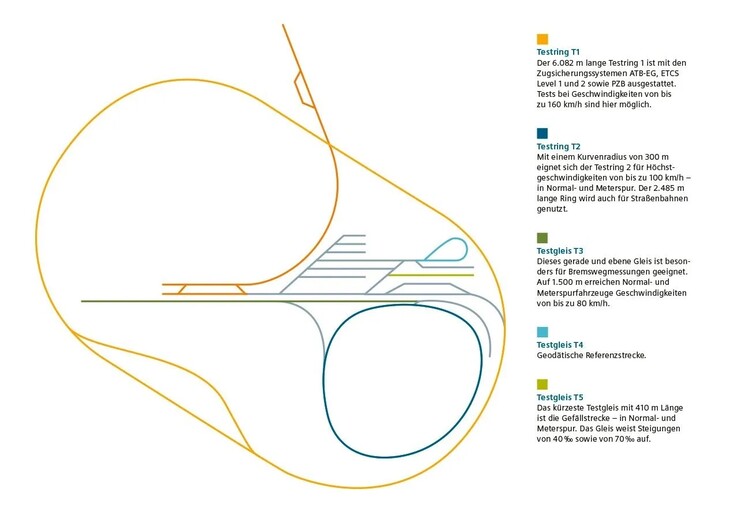 Layout of the test center (Image: Siemens)
Layout of the test center (Image: Siemens)
However, the rides were speed limited. Since the press on site were classified as passengers, the trains were not allowed to be run up to their maximum. This is 160 km/h (~99 mph) for both trains, although only the 140 km/h (~87 mph) option has been ordered for the hydrogen train so far.
In practice, such high speeds are likely to be rare anyway, after all, such trains run on lines that have so far been served by diesel railcars. These tend to travel at speeds of 120 km/h (~75 mph) or even slower, not least because of the lack of line upgrades, but also because of the short distances between stops.
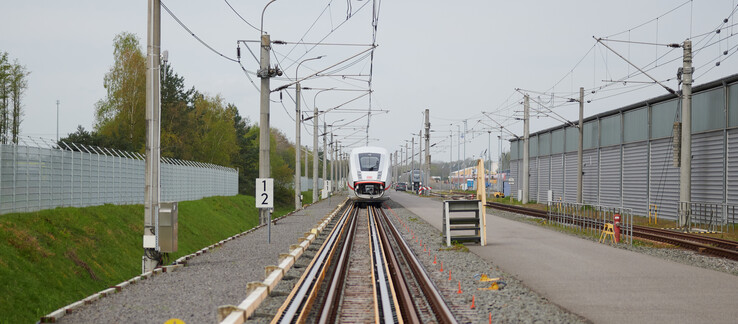 Three-line track (narrow gauge, standard gauge), 3rd/4th Rail for London, overhead catenary and a side busbar. A lot can be tested in the PCW. (Photo: Andreas Sebayang/Notebookcheck.com)
Three-line track (narrow gauge, standard gauge), 3rd/4th Rail for London, overhead catenary and a side busbar. A lot can be tested in the PCW. (Photo: Andreas Sebayang/Notebookcheck.com)
Diesel trains generally do not have good acceleration values. There are exceptions, for example in Japan very powerful diesel trains run between the electric trains on narrow-gauge lines around Kobe, but these are rare worldwide. The typical diesel train travels at a leisurely pace.
Not so the Mireo Plus H and Mireo Plus B. They accelerate almost as fast as a subway. Unlike diesel trains, the EMUs with the alternative drives are supposed to be able to “swim along” with the rest of the traffic under the catenary so that other trains don’t have to wait behind them. This stabilizes the cycle, even if individual parts of the route are not electrified.
Mireo Plus H – hydrogen for long distances
The most advanced new Mireo based vehicle at present is the Plus H variant. It made its press debut last year but was not allowed to run at full speed back then. This time, the two-car train was running at full power, although still not in a final configuration. Running on the Wegberg-Wildenrath Test and Validation Center (PCW) the train was visably showing lots of measuring and test equipment with temporary cables running through the train and even outside the train along the vehicle body. This test is needed for the certification, which is to be completed by the end of 2023, so that the train can enter passenger service.
Both the front and rear sections of the train have their own hydrogen refueling systems and tanks, according to Siemens. There is a simple reason – because there is no hydrogen line between the two train sections. This also provides redundancy. Siemens did not want to give any size information about the battery itself that is supporting the fuel cells, saying only that it corresponds to a “larger SUV” battery.
Development has even reached the point where it can, in principle, also be purchased as a three-car set, however, the center car will then not provide any acceleration since Siemens doesn’t offer Jacobs bogies (two cars share one bogie) with driven axles on the Mireo platform.
According to Siemens, the ride on the T2 test track was the first with a press audience where the train could demonstrate its performance when starting up. We quickly noticed the 1.1 m/s2 acceleration, because we suddenly had to hold on tight when the driver flipped the lever. It was a start-up behavior that rail passengers on overhead line-free lines simply don’t know.
In terms of noise, the train initially sounded like a normal electric multiple unit (EMU). After a while, however, there was a noticeable whistling noise. According to Siemens, this can be corrected with optimization. The noise comes from the fuel cell recharging the battery, up to 75 percent. The rest of the capacity remains free to absorb the braking energy.
In general, the fuel cell runs relatively constantly during operation. The reason for this is that it should be operated at its optimum and not supply energy inefficiently in low-load operation. This is what the battery is for, and in practice it is charged almost constantly. One exception might be start-up, because that’s when the battery is significantly drained, which we could also observe in the cab.
The driver has a display with bars for this. If the lower bar is blue, the system is recuperating. If the bar is red, energy is being drawn for propulsion.
Since fuel cells have a certain inertia, the battery provides the power of a typical electric train, while the fuel cell takes care of the range. Siemens isn’t the only company doing it this way. The fuel cell of the hydrogen train iLint in the Frankfurt am Main area is supported by batteries.
The range is 600 to 1000 km (~373 to 621 miles). That is enough, Siemens promises, to refuel the vehicle – like a diesel multiple unit (DMU) – only once a day. The Mireo Plus H needs 180 kg (~397 pounds) of hydrogen per tank load, which is refueled in gaseous form at up to 500 bar.
A further 20 kg (~44 lb) remains in the tank in any case. This is due to the carbon-fiber-reinforced construction of the energy storage system. Without a certain residual pressure, these would collapse. Put simply, the tank behaves much like a balloon, which also cannot hold its shape without pressure.
Regarding the refueling time, Siemens said that this is comparable to that of diesel trains. Deutsche Bahn stated that a quick refueling is completed in 15 minutes.
Mireo Plus B – with battery for short distances
The Mireo Plus B only has a range of about 120 kilometers (~75 miles) and is intended for routes with more electric infrastructure. The LTO battery is said to be three times larger that that of a Mireo Plus H, which as a train, weighs just as much as the Plus B overall.
Obviously, this is not enough to supply a line running completely under diesel.
But many regional trains pass a line with a catenary at some point during a round trip. The Mireo Plus B can then recharge at these points on the way and at the final destination. According to Siemens, the pantograph can be raised while the train is in motion. This would make it possible to charge the train while it is on the move. However, the Mireo Plus B can also be charged without an overhead line using a conventional cable. A full charge takes a good half hour.
At the same time, the power grid is heavily loaded, so charging stations can’t be set up everywhere. This is likely to pose challenges in terms of scheduling, because a train like this cannot simply be stranded somewhere with an empty battery. According to Deutsche Bahn, which is currently developing a mobile refueling system for hydrogen trains, it is difficult to allow power peaks in the power grid on the periphery of a network.
There were no differences in driving experience between Mireo Plus B and H. This was also confirmed by the driving personnel. According to the driver who led us around, a Mireo Plus B is a bit easier to handle than a normal Mireo, because the transition points under the overhead line do not have to be considered. Apart from that, the driver said, there are no differences.
By the way, both Mireo are designated as class 563 in Germany, so there is no distinction between fuel cell or pure battery. Trains with 500 series numbers are multiple units with alternative drives. An overview of the series logic is provided by a Wikipedia article.
Technical similarities
Mireo Plus H and Mireo Plus B are based on the Mireo platform from Siemens. These are lightweight commuter trains that have been on the tracks for several years.
There are some common features that both Plus H and Plus B have. For instance, both use lithium titanate batteries under the vehicle floor. The Plus H uses the batteries as an additional power source to the fuel cell, which needs support when starting up quickly, and the Plus B uses them as general energy storage.
LTO (lithium titanium oxide) batteries are not unusual for railroads, and the energy storage system has nothing in common with the tape technology known to IT people as LTO (linear tape open), on which data is stored. Toshiba’s shunting (switching) locomotive for Deutsche Bahn, for example, uses LTO batteries.
Siemens also already has experience with battery technology because of a rebuild of a Desiro ML some years ago. The batteries are expected to last roughly 10 to 15 years, so would only need to be replaced once before the train is taken out of service as scheduled.
Both trains have a propulsive power of 1.7 MW, with which the 1.1 m/s2 can be converted as acceleration. This is already a high value in regional traffic, even for electrically driven trains. Locomotive-hauled trains and high-speed trains in particular rarely achieve such values.
Application scenarios around Berlin
In addition to the projects already known in Baden-Württemberg and Bavaria, the Mireo Plus family will also be used in and around Berlin (in the Berlin-Brandenburg Transport Association, VBB). A full 38 vehicles have been ordered by Niederbarnimer Eisenbahnen (NEB): Seven Plus H and 31 Plus B. The trains will be used on lines where electrification is planned, but such projects sometimes take decades in Germany.
The Mireo Plus is scheduled to run as early as the timetable change at the end of 2024. For orientation, we recommend a look at the VBB network spider (PDF) at https://www.vbb.de/fileadmin/user_upload/VBB/Dokumente/Liniennetze/bahn-regionalverkehr-brandenburg-und-berlin-mit-plusbus-linien.pdf.
The fuel cell trains are intended for use on the Heidekrautbahn (RB27)and will be maintained there by NEB. With seven units, this will be the largest Mireo Plus H fleet at present. Siemens is also building one vehicle each for two other projects.
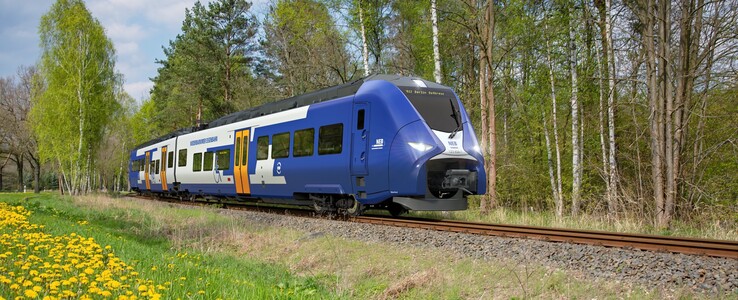 The design of the Mireo Plus B for the East Brandenburg network. (Image: Siemens Mobility/NEB)
The design of the Mireo Plus B for the East Brandenburg network. (Image: Siemens Mobility/NEB)
If the reconstruction of the main line is successful by then – skepticism is warranted here – trains would even run regularly as far as Berlin-Wilhelmsruh. Currently, only a few trains go as far as Berlin-Gesundbrunnen and the rest end in Berlin-Karow. But this also means that the trains have no chance to get to a catenary for charging for a longer time (Non-electrification map of the Heidekrautbahn on Openrailwaymap).
Trains do run under catenary between Karow and Gesundbrunnen, but that is only a short distance and alternatively trains would have to block platforms at Gesundbrunnen to charge. That would be impractical for operations, especially since not all trains travel that far. Many go to Berlin, for example, during rush hour, but otherwise remain on the Heidekrautbahn network.
That leaves Karow for charging. Karow is electrified, but via a lateral conductor rail for the S-Bahn. The RB27 stops here at an S-Bahn platform, but can’t simply charge there because of the S-Bahns, some of which run every 10 minutes.
The Mireo Plus H trains ordered can at least stop halfway at an S-Bahn platform, since they have a boarding height of 800 mm (~2.6 feet), which is untypically high for regional trains and still remains somewhat below the S-Bahn platform (960 mm/~3.2 ft). The Mireo Plus B, on the other hand, were ordered with a boarding height of 600 mm (~2 ft), which is a significant drop down to the train. In both cases, there are problems with boarding height/step-free access.
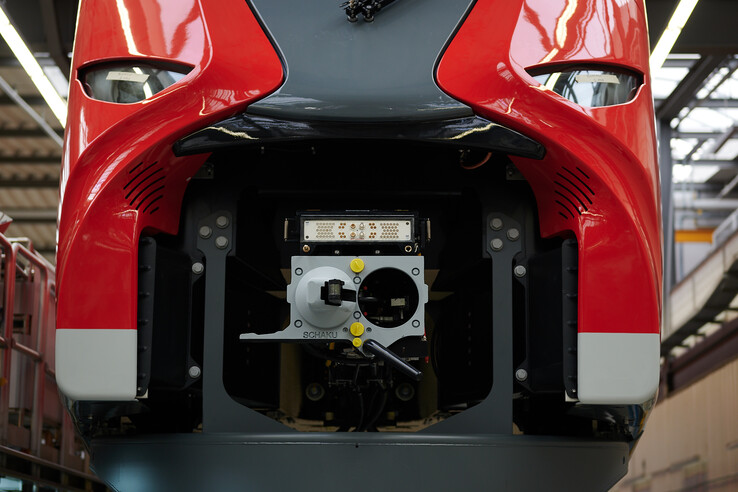 A new standard Mireo is completed in Krefeld. (Photo: Andreas Sebayang/Notebookcheck.com)
A new standard Mireo is completed in Krefeld. (Photo: Andreas Sebayang/Notebookcheck.com)
Hydrogen is therefore obviously the better option for the Heidekrautbahn network. The fuel for the Mireo Plus H will be produced locally in a joint project with Enertrag. Mainly solar cells will be used for energy production, NEB said. But some of the hydrogen will also be produced by wind power. Hydrogen from waste, as used in Frankfurt am Main for the iLints, is not to be used.
The rest of the Mireo Plus fleet, or 31 trains, will be used as B versions with rechargeable batteries on the lines of the East Brandenburg network. This is also a large fleet. Siemens has a total of 61 Mireo Plus H in its order books, including a project in Denmark.
In the East Brandenburg network, there are regular and frequent access points to the overhead line in each case. Either the trains stand longer at a terminus or can recharge their batteries on a larger section in each round trip.
Nevertheless, NEB will set up two charging stations at terminus points. In Templin (RB12) and Werneuchen (RB25), these are to be built far away from the rest of the network. Actually, these are not terminal stops, but in Brandenburg, more and more lines have been shut down in recent decades. Templin has only been the end of a line again for a few months.
Two more charging stations are being built “right in the middle”. One is being built roughly halfway along the RB36 in Beeskow and one for the RB60 in Wriezen. This is also a “halfway terminus,” since shorter commuter trips end there.
According to NEB, the four charging stations will only be used during stabling, not when the trains are in operation.
For the remaining lines (RB26, RB35, RB61, RB62, RB63), the electric infrastructure is apparently sufficient.
Battery trains also run under the overhead line in some cases
This applies in particular to the RB62 and RB63 regional rail lines in the northeast. There, the Mireo Plus B trains run entirely under overhead lines. The use of battery trains there was a condition of the invitation to tender https://www.vbb.de/presse/vergabeverfahren-netz-ostbrandenburg-die-niederbarnimer-eisenbahn-neb-erhaelt-den-zuschlag/. This decision, which at first glance seems like a faux pas, probably has something to do with vehicle scheduling and uniform fleet planning. This was also confirmed by NEB when asked by Notebookcheck.com. For the routes in question, NEB would need two electric multiple units (EMU). The NEB says “A mixing of the deployed fleet with 2 EMU to 29 BEMU would not have been economically justifiable (reserve vehicles/spare parts)” and also confirms that the catenary are generally driven with pantographs.
The RB26 is special because it runs all the way to Poland. However, the Mireo Plus B trains do not have the necessary approval and safety equipment. It should be noted that cross-border rail traffic is an extremely complex subject that would go beyond the scope of this article. To put it simply, most multiple units and locomotives cannot simply travel to a neighboring country.
Trains running as far as Poland will continue to run on diesel (Polish Pesa Link), while shorter commuter runs within Germany – should they actually become a reality – will be served by the Mireo Plus B.
Update May 24, 2023: The text has been supplemented with answers from Niederbarnimer Eisenbahn.
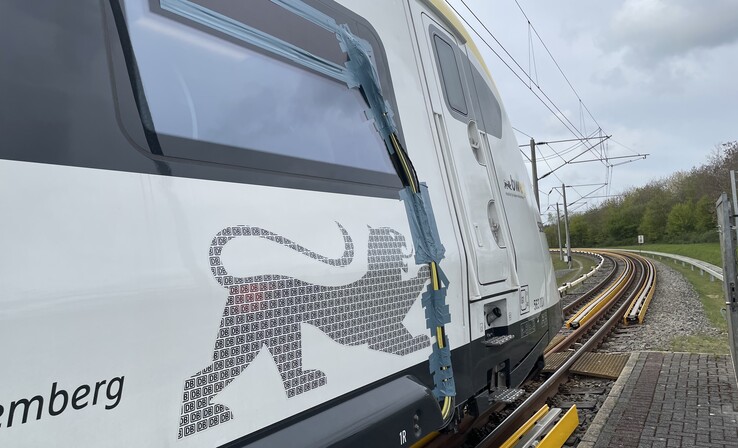 Visible test cabling on the Mireo Plus H. A few more approval runs are necessary before use. (Photo: Andreas Sebayang/Notebookcheck.com)
Visible test cabling on the Mireo Plus H. A few more approval runs are necessary before use. (Photo: Andreas Sebayang/Notebookcheck.com)
Transparency
The author received information about this article in the context of an event hosted by the manufacturer. Any travel and accommodation costs were fully or partially covered by the manufacturer. The manufacturer had no influence on this article, nor was there any obligation to publish it.

I’ve been involved in the IT business for over 20 years, first as a Sysadmin (Mac & PC; 2000-2014) and then as a journalist (2005 onwards). I have attended many industry events, such as IDF, Displayweek, Computex, CES, and IFA, to cover subjects like mobile and local networks, Bluetooth standards, and developments in the mobile sector. Since 2017 I have also worked as an aviation journalist, which involves traveling around the world reporting about both planes and trains.

Translator: Ninh Ngoc Duy – Editorial Assistant – 313307 articles published on Notebookcheck since 2008
My main responsibility as an editorial assistant is maintaining the Library section, which aggregates reviews from other publications and channels. In addition, my daily breakfast is Notebookcheck’s long list of new content, which I comb through to select the most interesting topics for translation from English to French, Italian, Spanish, Portuguese, and Dutch.”
Andreas Sebayang, 2023-06-23 (Update: 2023-06-23)
>>> Read full article>>>
Copyright for syndicated content belongs to the linked Source : NotebookCheck – https://www.notebookcheck.net/Mireo-Plus-B-H-Battery-and-hydrogen-powered-trains-tested-on-Siemens-rail-test-facility.726579.0.html




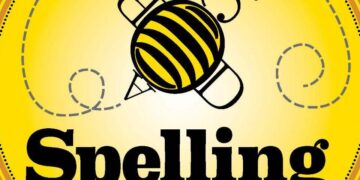











![[News] China Makes Breakthrough in Chip Technology, Paving the Way for Lithography Advancements – TrendForce](https://earth-news.info/wp-content/uploads/2025/11/324664-news-china-makes-breakthrough-in-chip-technology-paving-the-way-for-lithography-advancements-trendforce-360x180.jpg)
